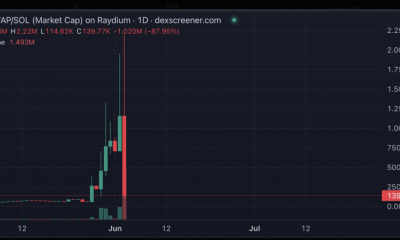

De-fi
Next stage of web3 evolution will be underpinned by zero knowledge tech – Crypto News
While the blockchain industry has correctly pointed out key issues in the worlds of legacy tech, finance, art, and culture, the revolution promised is yet to materialize, with the tools being designed to address those challenges are not yet at the required standard.
Technical inefficiencies have stifled the development of truly decentralized systems, and decentralized finance (DeFi) platforms have shown vulnerabilities to data breaches of their own. From January to November 2023, over $1.7M in assets was lost due to hacks, with nearly 300 specific incidents.
As we begin 2024, things are looking brighter due to ongoing developments in zero knowledge (ZK) technology, which could be the key to unlocking the benefits of truly decentralized digital platforms. After gaining momentum in 2023, primarily through innovation in scaling solutions, the continued growth of the ZK industry this year should see a diversification and proliferation of use cases including important advancements in the areas of data protection, privacy, and compliance.
In bringing more secure and efficient tools to blockchain developers, the widespread benefits of ZK technology will start to be felt, with 2024 seeing a broader range of applications across different industries. Rather than being deployed within isolated Web3-native use cases aiming to compete with traditional finance and tech, ZK tech can be integrated into legacy systems and platforms, imbuing them with the benefits of the decentralized values of crypto, significantly enhancing user empowerment. It achieves this by ensuring robust data control and privacy preservation, thereby facilitating a more liberated and secure usage experience without compromising the users’ peace of mind.
Zero Knowledge Scalability Continues to Advance
Simply put, zero knowledge proofs (ZKPs) allow one party, the prover, to validate a statement to a verifier without revealing anything other than this specific truth. In practice, ZKPs allow complex computations to be performed off-chain, reducing congestion on the blockchain.
This has proved revolutionary to the Ethereum ecosystem, where rising demand for blockspace has led to an increasingly congested network with high fees, creating barriers to mass adoption. Scaling solutions like sharding, sidechains, state channels, and rollups have helped tackle scalability issues to improve developer and user experience while maintaining Ethereum’s well-regarded security and transparency values.
The same properties that make ZK ideal for reducing congestion on decentralized networks also bring greater data protection benefits. Looking ahead, we can expect to see more projects harnessing ZK tech for a variety of use cases, not just for scaling but also for data protection and compliance, which will lay the groundwork for major changes in Web2 and Web3.
ZKPs Broaden the Scope for User Data Protection
Putting aside all the benefits of scalability, it will be data protection that proves to be the killer use case for ZKPs, underpinning all other functions in blockchain applications. For context, data protection is a broader term than privacy as it encompasses security, integrity, and accessibility.
Data protection and privacy are often afterthoughts for people interacting online. This is by design – traditional digital platforms lure users in with free access and services, hiding the true cost in the fine print to collect and utilize valuable user data for analytics, targeting, and advertisement purposes.
However, recent surveys reveal that consumers are increasingly worried about the risk of data breaches and privacy infringements from their tech devices, with up to three-quarters of survey respondents agreeing they should do more to protect themselves.
As data breaches get more costly – amounting to 4.45 million U.S. dollars on average in 2023 – projects across various industries are seeking innovative solutions to prevent and reduce the impact of hacks and exploits. By empowering users to store personal information off-chain and enabling secure sensitive data disclosure, ZKPs can reduce vulnerabilities caused by the collective storage of data, which has been a prime target for hackers.
In 2024, the industry can expect a number of ZK-based privacy tools to advance and become user-ready, for example, ZK-login tools to streamline access to DeFi platforms, and ZK-based decentralized voting mechanisms to balance integrity and anonymity.
ZK Use Cases Outside of the Blockchain Space
ZK technology can also address key data management problems in other sectors, proving to be a breakthrough tool for the mass adoption of blockchain technology.
With increasing concerns about data breaches from users, traditional social media and Web2 platforms, which are often built on a data mining model, could integrate privacy-enhancing features for users powered by ZK technology, such as secure end-to-end messaging.
In other cases, it may be institutions required to safeguard sensitive data sets that are the first adopters of ZKPs for privacy. For example, in supply chain management, logistics, and telemetry, ZKPs can be used to verify activity while disclosing the least amount of data necessary between two parties. Not only is this efficient, but it can also be important for maintaining intellectual property rights and reducing the data management burden of any one party.
Likewise, governments and other institutions that deal with sensitive data can adopt decentralized identifiers (DiDs) which can be used to verify identity and other information while optimizing for privacy. Since 2014, residents in Estonia have been granted a state-issued digital identity for access to public services, a model that the European Union is seeking and several countries are on the path to emulate.
ZKPs Enable DeFi With a Path Towards Compliance
Collaboration with traditional financial institutions could bring much-needed liquidity to DeFi, but integrations have previously been stifled by contradictions between the principles of anonymity and privacy associated with DeFi and the KYC requirements banks and large-scale investment corporations must abide by in many jurisdictions. By the same measure, traditional businesses may be put off by the transparent properties of the blockchain, not wishing to have the details of every transaction documented on a public ledger.
With the use of ZKPs, DeFi platforms can verify that a user meets KYC requirements and also verify transactions without revealing identifying information or other superfluous information, striking a balance between DeFi values and TradFi responsibilities. For example, a report by Etonec demonstrates how ZKPs can be used for compliance in a privacy-preserving fiat stablecoin system.
Similar to privacy-optimizing solutions, ZKPs can offer more customizable compliance options, tailored to user needs. This is important because individuals have unique preferences when it comes to convenience and data protection. To deliver financial freedom to the masses, DeFi platforms need to offer a wide range of options for users.
Developer-Friendly Tools Accelerate Innovation On All Fronts
ZKPs support the modular evolution of blockchain, providing the building blocks to enable key functions like scaling, privacy, compliance, and importantly, interoperability.
In contrast to a monolithic blockchain like Bitcoin where all transactions are executed on a single layer, modular blockchains delegate functions to specific modules that make up an interoperable system. By reducing the workload of any specific component, modular blockchains reduce the likelihood of bugs and enable more efficient development.
In the current landscape, layer-1 protocols are seen as competing, but with the modular evolution of blockchain, the notion of the blockchain layer will morph into more of a notion of modular building blocks. As small attestations of data that can be cheaply verified and bridged across chains, ZKPs will become the glue holding this interconnected system together.
With the specialization of tasks, each module will be able to advance faster – developers can focus on improving compliance, for example, because scaling is already being taken care of, leading to increased experimentation and innovation on all fronts.
What’s On the Horizon in 2024
In a constantly changing industry landscape and macroeconomic environment, adaptability is the key to the survival of any technology. Zero knowledge proofs have proven to be just that – an infinitely adaptable tool for addressing a wide range of challenges. Harnessing the power of ZK, this coming year we will begin to see the expansion of use cases beyond scaling, with a primary focus on data management, attestations, and applications across various sectors.
-

 others1 week ago
others1 week agoCustomer Who Stole $830,000 From Wells Fargo After Initiating Fraudulent Payments Sentenced to Prison – Crypto News
-

 Blockchain1 week ago
Blockchain1 week agoAmerican Rapper Cardi B Endorses WAP Token Again—But Is It A Rugpull? – Crypto News
-

 Cryptocurrency1 week ago
Cryptocurrency1 week agoShiba Inu burn surges 2,408%: Can SHIB finally escape bearish pressure? – Crypto News
-

 Technology1 week ago
Technology1 week agoApple WWDC 2025: How to watch the keynote and what all to expect – Crypto News
-

 Blockchain5 days ago
Blockchain5 days agoEthereum Price Performance Could Hinge On This Binance Metric — Here’s Why – Crypto News
-

 Technology1 week ago
Technology1 week agoGoogle Search now shows AI-generated weather snapshots for select users: Report – Crypto News
-

 Cryptocurrency1 week ago
Cryptocurrency1 week agoCrypto ATM scams in Australia cause over AUD 3.1 million in losses – Crypto News
-

 Blockchain1 week ago
Blockchain1 week agoJPMorgan to Accept Bitcoin ETFs as Loan Collateral – Crypto News
-

 Technology1 week ago
Technology1 week agoBest water purifiers under ₹15000: Explore the top 6 options from Aquaguard, Urban Company and more – Crypto News
-

 Cryptocurrency1 week ago
Cryptocurrency1 week ago$106,313,218 Solana (SOL) In One Transfer — What Happened? – Crypto News
-

 Technology1 week ago
Technology1 week agoTop 5 AI tools in 2025 to boost your productivity, stay ahead and help you save time – Crypto News
-

 others1 week ago
others1 week agoCanadian Dollar lurches into fresh highs after BoC holds off on rate cuts – Crypto News
-

 Technology1 week ago
Technology1 week agoFinal Fantasy Tactics returns once again with remastered edition – The Ivalice Chronicles; all details here – Crypto News
-

 Cryptocurrency6 days ago
Cryptocurrency6 days agoFrench Exoskeleton Company Wandercraft Pivots to Humanoid Robots – Crypto News
-

 Cryptocurrency6 days ago
Cryptocurrency6 days agoFrench Exoskeleton Company Wandercraft Pivots to Humanoid Robots – Crypto News
-

 others6 days ago
others6 days agoCanadian Dollar gives back gains despite upbeat jobs data – Crypto News
-

 Technology6 days ago
Technology6 days agoGemini can now schedule tasks, send reminders and keep you on track: Here’s how it works – Crypto News
-

 Technology6 days ago
Technology6 days agoBest juicer for home in 2025: Top 10 choices for your family’s good health from brands like Philips, Borosil and more – Crypto News
-

 Blockchain4 days ago
Blockchain4 days agoOpenLedger Invests $25 Million to Combat ‘Extractive’ AI Economy – Crypto News
-

 others4 days ago
others4 days agoGold price in India: Rates on June 10 – Crypto News
-

 Blockchain1 week ago
Blockchain1 week agoSolana Analyst Sets $300 Target – Can Bulls Sustain A Rally? – Crypto News
-

 Cryptocurrency1 week ago
Cryptocurrency1 week agoTrump-Elon feud Erupts, Crypto falls, Coinbase to list Fartcoin – Crypto News
-

 others1 week ago
others1 week agoGold prices fall as the USD extends gains post NFP – Crypto News
-

 Technology3 days ago
Technology3 days agoCircle IPO shows strong crypto market investor demand – Crypto News
-

 Technology1 week ago
Technology1 week agoDashcam buying guide: 5 things to know before making a purchase in 2025 – Crypto News
-

 Blockchain1 week ago
Blockchain1 week agoJPMorgan Plans to Allow Financing Against Crypto ETFs: Report – Crypto News
-

 Technology1 week ago
Technology1 week agoWhy Anthropic CEO Dario Amodei thinks a 10-year AI regulation freeze is dangerous – Crypto News
-

 Technology1 week ago
Technology1 week agoThe Quiet Voices Questioning China’s AI Hype – Crypto News
-

 Cryptocurrency1 week ago
Cryptocurrency1 week agoDonald Trump Ready to Ditch His Tesla Amid Musk Feud? (Report) – Crypto News
-

 Technology1 week ago
Technology1 week agoMicrosoft integrates AI shopping into Copilot app, bringing price tracking and smart comparisons – Crypto News
-

 Technology6 days ago
Technology6 days agoWeekly Tech Recap: Resident Evil Requiem release date revealed, OnePlus 13s makes India debut and more – Crypto News
-

 Technology5 days ago
Technology5 days agoOpenAI CEO Sam Altman says AI is like an intern today, but it will soon match experienced software engineers – Crypto News
-

 Cryptocurrency1 week ago
Cryptocurrency1 week agoBest crypto to buy as Truth Social files for a Spot Bitcoin ETF – Crypto News
-

 others1 week ago
others1 week agoUSD/INR flat lines amid US Dollar demand, equity outflow – Crypto News
-

 others1 week ago
others1 week agoXAG/USD remains positive, supported above $34.00 – Crypto News
-

 others1 week ago
others1 week agoEUR/USD retreats from multi-week highs ahead of Eurozone GDP and consumption data – Crypto News
-

 others1 week ago
others1 week agoBitcoin Could Crash by Double-Digit Percentage Points in a ‘Quick Move’ if This Support Level Fails, Warns Crypto Trader – Crypto News
-

 others7 days ago
others7 days agoWidely Followed Analyst Outlines Bullish Path for Bitcoin, Says BTC Will Battle Gold and ‘Never Look Back’ – Crypto News
-

 Technology6 days ago
Technology6 days agoBest juicer for home in 2025: Top 10 choices for your family’s good health from brands like Philips, Borosil and more – Crypto News
-
![Stacks [STX] down 31% after Alex Protocol exploit - Details](https://dripp.zone/news/wp-content/uploads/2025/06/Stacks-STX-down-31-after-Alex-Protocol-exploit-Details.webp-400x240.webp)
![Stacks [STX] down 31% after Alex Protocol exploit - Details](https://dripp.zone/news/wp-content/uploads/2025/06/Stacks-STX-down-31-after-Alex-Protocol-exploit-Details.webp-80x80.webp) Cryptocurrency6 days ago
Cryptocurrency6 days agoStacks [STX] down 31% after Alex Protocol exploit – Details – Crypto News
-

 Technology6 days ago
Technology6 days agoHow artificial intelligence caught leukaemia in Maharashtra’s Parbhani – Crypto News
-

 Cryptocurrency5 days ago
Cryptocurrency5 days agoTRON: Who’s fueling TRX’s breakout? It’s not whales, here’s the answer! – Crypto News
-

 others1 week ago
others1 week agoCustomer Who Stole $830,000 From Wells Fargo After Initiating Fraudulent Payments Sentenced to Prison – Crypto News
-

 Cryptocurrency1 week ago
Cryptocurrency1 week agoSolo Miner Defies Odds After Mining Bitcoin Block Earning Over $330K – Crypto News
-

 Blockchain1 week ago
Blockchain1 week agoMaple Expands to Solana, Brings Yield-Bearing Stablecoin – Crypto News
-

 Metaverse1 week ago
Metaverse1 week agoThe transformer birthed GenAI. Meet the man who built it – Crypto News
-

 others1 week ago
others1 week agoGBP/USD slips as strong US jobs data cools Fed rate cut bets – Crypto News
-

 Blockchain1 week ago
Blockchain1 week agoDeutsche Bank Considers Digital Asset Projects – Crypto News
-

 others1 week ago
others1 week agoS&P 500 reaches 6,000 for first time since February on NFP print – Crypto News
-

 Technology5 days ago
Technology5 days agoIndia targets indigenous 2nm, Nvidia-level GPU by 2030 – Crypto News
















